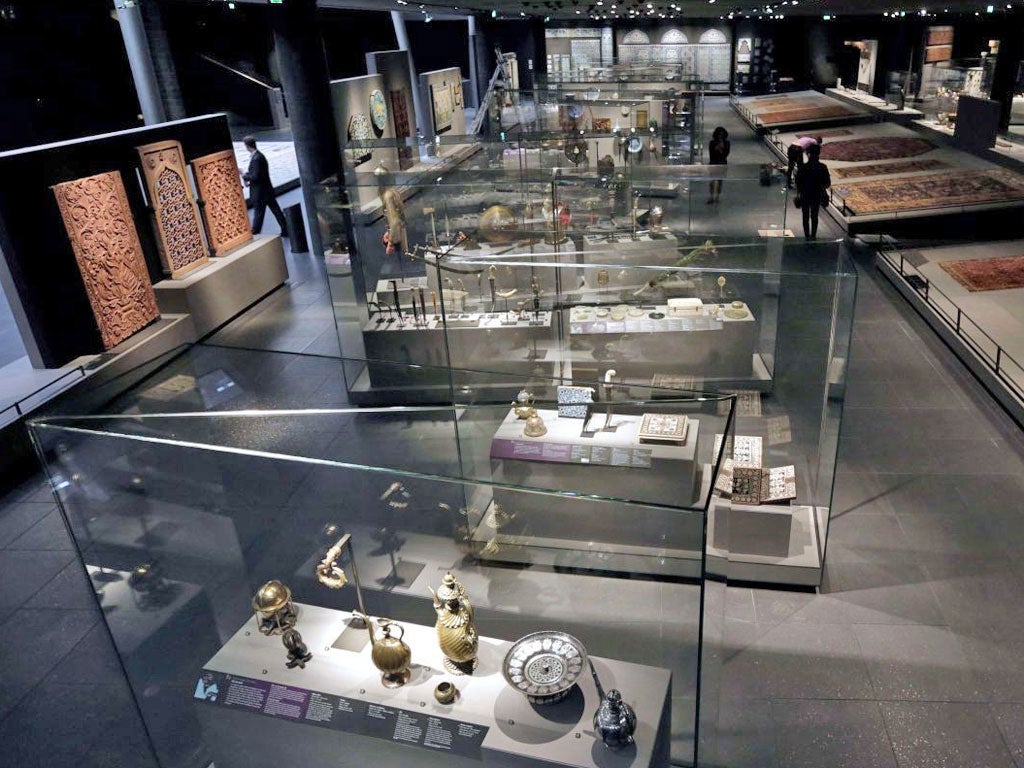These 'fanatics' created some of history's finest art
The Louvre's exhibition of Islamic art fills Robert Fisk with wonder

On sale outside the Louvre's spanking new exhibition of Islamic Art this weekend was a magazine headline to engage any reader. "Les fanatiques," it read. The fanatics in question were not Texas pastors or Californian video-makers who burn Korans or insult the Prophet Mohammed. "Les fous de dieu" – the "madmen of god" as the French press usually calls them – are not the mid-West Christian Apocalypse-believers who support Israel and claim, if you believe the latest posters on the New York subway, that they are fighting "savages".
Oh no, indeed, the fanatics, crazies and savages in question are the chaps who created the Islamic treasury of golden chalices and crimson rugs and silver vases and marble friezes and bronze lions and stone-paste roosters and vast, brass candlesticks beneath the golden "desert" roof of the Louvre's latest exhibition hall. Even the sumptuous new catalogue which the museum has published to mark the occasion, while padded with the worst of academe's latest clichés – "dialogue" used as a verb, and far too much "inclusivity" and "interaction" and "spaces" – admits the importance of these glories "in these times preyed on by obscurantist aspirations and extremist tendencies of every kind".
These words were written by a Muslim – and he certainly wasn't talking about Mr Breivik or the torturers of Guantanamo and Bagram. For what lies behind the fervour with which we are expected to view these masterpieces of Islamic art in Paris is a simple idea: that Muslims are not all raving, bearded, hand-chopping ambassador-killing head-bangers, but inheritors of one of the world's greatest cultures, entwined within a tolerant religion, enhanced by learned men (alas, few women) who admitted Jews and Christians into their Islamic society and who produced some of the finest art in history.
So what should be our reaction to this exhibition of "Islamic art"?
Wonder, must be one reaction. The 1144 (AD) celestial globe of Yunus ibn al-Husayn al-Asturlabi – an astrolabe, indeed, of the spheres, a three dimensional model of the entire universe – in which al-Husayn has almost perfectly modified the sky's dimensions between Ptolemy's calculations and the era of the Prophet (15 degrees and 18 minutes), its 1,025 stars represented by inlaid silver dots. Ride across the 12th-century Middle East desert at night and you'd need one of these in your saddle-bag.
Yes, wonder. Ottoman calligraphy – did the West create anything to match this? – and flower paintings that could adorn any European mediaeval panel, and a carpet of the garden of paradise; and then there's a 1599 painting of the Mughal Emperor Jahangir holding a portrait of his father Akbar; and while Jahangir looks sternly at his father, Akbar stares back at his son with an expression of frowning disapproval; Jahangir had vainly tried to depose Akbar 14 years earlier.
So humour, too. Perhaps Islam needed that to survive the devastation of Ghengis Khan.
Which brings me to my saddest reflection. Has Islamic art produced anything that is non-derivative this past century? (Or Christian art, for that matter – and please don't talk to me about the "new" Coventry Cathedral). And if not, why not? Has technology taken over? Are we to conclude that Islamic culture could survive the horrors of Ghengis Khan – but not the invasion of CNN?
Subscribe to Independent Premium to bookmark this article
Want to bookmark your favourite articles and stories to read or reference later? Start your Independent Premium subscription today.

Join our commenting forum
Join thought-provoking conversations, follow other Independent readers and see their replies